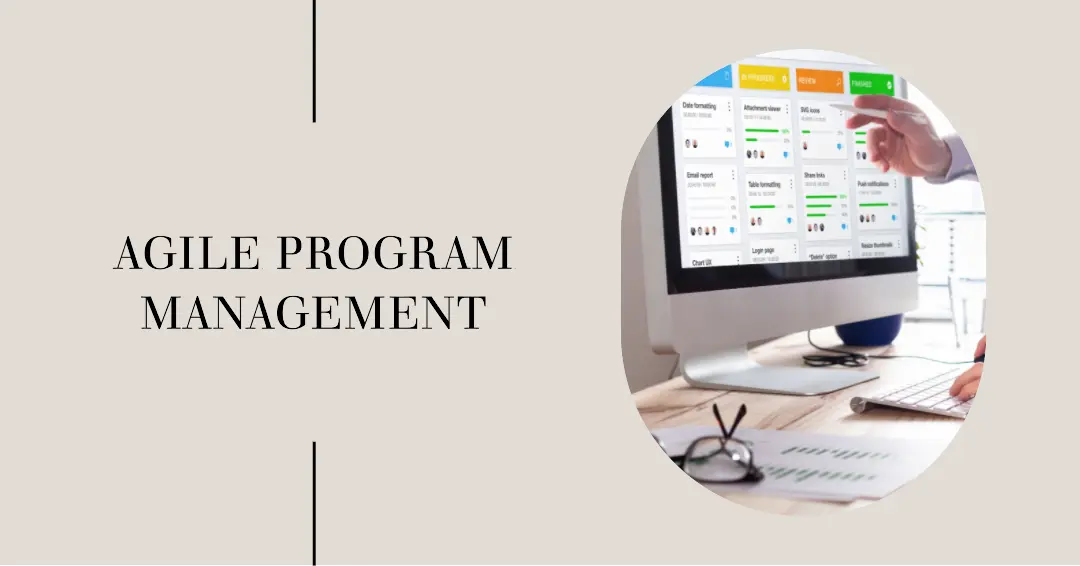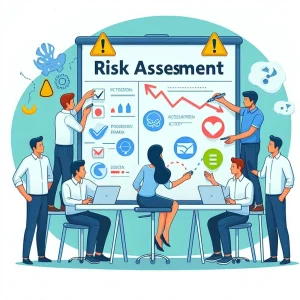To find out how Artificial Intelligence is changing the Project Management landscape, you may enjoy reading this article https://www.shaunstoltz.com/did-artificial-intelligence-just-change-everything-about-project-management/
I. Introduction
Welcome, project management enthusiasts. You’ve landed on this page because you’re curious about how to supercharge your program management skills, right? Or perhaps you’re wondering how Agile, a methodology that’s taken the software development world by storm, might apply to your role as a program manager? Well, you’ve come to the right place!
In the dynamic, fast-paced world we’re operating in, efficiency and adaptability aren’t just nice-to-haves anymore – they’re absolute essentials. From navigating unexpected changes to handling high-stakes projects, program managers are constantly expected to do more with less, and do it faster. If that sounds like a tall order, I have some good news for you: Agile might just be the game-changer you’ve been waiting for.
Agile is more than just a buzzword. It’s a way of thinking, a philosophy rooted in flexibility, collaboration, and customer centricity. Originating in the realm of software development, Agile principles have demonstrated their versatility, proving to be effective beyond their birthplace. And today, we’re going to explore how these principles can breathe new life into program management.
So, buckle up and join me on this journey of discovery! As we delve into the world of Agile Program Management, we’ll uncover insights, strategies, and actionable tips that could revolutionize the way you manage your programs. Let’s get started, shall we?
II. Understanding Agile Principles
Alright, friends, let’s take a step back before we dive into the deep end of Agile program management. To understand how Agile can revolutionize your approach to program management, we first need to grasp what Agile is all about. Picture this as your ‘Agile 101’ crash course!
The term ‘Agile’ might sound like it’s all about speed, but there’s much more to it. Agile is a philosophy, a mindset that champions adaptability, customer satisfaction, and continuous improvement. Born out of the software development industry in the early 2000s, Agile was a response to traditional, linear methods that struggled to keep up with rapid changes and customer demands. Remember the era of floppy disks and dial-up modems? Yeah, we’ve come a long way since then!
At the heart of Agile are four core values, as outlined in the Agile Manifesto:
- Individuals and interactions over processes and tools: Agile values human elements—people doing the work and how they work together.
- Working software over comprehensive documentation: The focus is on delivering usable products rather than getting bogged down in documentation.
- Customer collaboration over contract negotiation: Agile promotes a customer-focused approach that involves the client throughout the process.
- Responding to change over following a plan: Agile encourages flexibility as a way of dealing with the unpredictable nature of software development.
Now, I know what you’re thinking: “This all sounds great, but I’m not a software developer. How does this apply to me as a program manager?” That’s a fantastic question, and I’m glad you’re thinking along these lines.
The beauty of Agile principles is their universal applicability. They’re not about coding or testing software; they’re about working smarter, responding effectively to change, and delivering value. And who doesn’t want that in their program management toolbox, right?
In our next section, we’ll explore how traditional program management compares to Agile program management. It’s like comparing your old flip phone to the latest smartphone—both can make calls, but one does so much more. So, stick around, and let’s continue this Agile journey together!
III. Traditional Program Management vs Agile Program Management
Let’s get into the meat and potatoes of our discussion, shall we? Picture this: You’re at a crossroads. One path is the well-trodden road of traditional program management, and the other, a newer, less familiar route marked ‘Agile Program Management.’ Let’s explore what each path offers.
First, let’s talk about traditional program management. It’s a bit like your grandmother’s secret recipe. It’s been around for a long time, and it’s familiar. Traditional program management is characterized by a heavy emphasis on upfront planning, strict control over changes, and a linear, sequential approach – think ‘Waterfall’ methodology, where one phase of a project must be completed before the next one begins. It’s like following a roadmap for a cross-country trip where detours are frowned upon, and you’re expected to stick to the pre-planned route.
Now, this approach has its merits. It’s structured, predictable, and it can work well for projects where requirements are clearly defined and unlikely to change. But, let’s face it, we live in a world that’s anything but predictable. In an era of constant change and innovation, the traditional approach can feel a bit like trying to navigate a winding forest trail with a roadmap instead of a compass.
Enter Agile Program Management. It’s like swapping out that roadmap for a GPS navigation system that recalculates your route when you encounter an unexpected roadblock. Agile Program Management is about being flexible, adaptable, and responsive. It’s about breaking down your program into smaller, manageable chunks (called ‘iterations’) and tackling them one at a time, while always being open to changing directions based on feedback and learning.
The beauty of Agile lies in its embrace of change. It’s not something to be feared or resisted but a reality to be prepared for. It’s about delivering value continuously, collaborating closely with stakeholders, and encouraging self-organizing teams that can adapt on the fly.
So, if traditional program management is a stately waltz, Agile program management is more like a salsa dance—dynamic, fluid, and exciting!
In our next section, we’ll deep dive into how each Agile principle can be applied to program management, complete with real-life examples. So, don’t go anywhere, we’re just getting to the good part!
IV. Application of Agile Principles to Program Management
Alright, folks! It’s time to roll up our sleeves and get down to the nitty-gritty. We’ve talked about what Agile is, and we’ve compared traditional program management with its Agile counterpart. Now, let’s discuss how to apply Agile principles to program management.
Individuals and interactions over processes and tools: Traditional program management can sometimes feel like a juggernaut, with its heavy emphasis on processes and tools. But here’s a secret: Your team, the individuals and their interactions, are your most valuable resource. In Agile program management, we empower our teams. We trust them to make decisions, to self-organize. We foster an environment that encourages communication and collaboration. Remember, a high-performing team can adapt to changing conditions far quicker than any process or tool.
Working software over comprehensive documentation: Now, I know you’re not delivering software, but this principle is all about focusing on producing tangible, usable results instead of getting lost in exhaustive documentation. As an Agile program manager, your goal is to deliver value to your stakeholders quickly. This could mean breaking down your program into smaller projects or phases and aiming to deliver usable outcomes at the end of each phase. It’s about progress, not paperwork!
Customer collaboration over contract negotiation: This is one of my favorites. In Agile program management, we embrace a deep, ongoing relationship with our stakeholders. It’s not about meeting the terms of a contract; it’s about collaboration, partnership, and working together to deliver the best possible results. Keep your stakeholders in the loop, seek their feedback, and make them an integral part of your journey.
Responding to change over following a plan: Lastly, but most certainly not least, Agile program management is all about being adaptable. It’s about recognizing that change is not a disruption, but a part of the journey. So, instead of following a rigid plan, Agile encourages us to be responsive, to learn from our experiences and to adjust our course as needed. It’s about being resilient in the face of change.
To illustrate, let’s look at a real-life example. A global marketing company, facing a highly competitive and rapidly changing market, decided to transition from traditional to Agile program management. Their teams were empowered to make decisions, processes were streamlined, and they started delivering value in smaller, more frequent increments. The stakeholders were actively involved in the process, and the teams were given the freedom to adapt to changes quickly. The result? Increased productivity, happier stakeholders, and a more resilient organization.
In the next section, we’ll explore the benefits of adopting Agile in program management. So, stay tuned and let’s keep the Agile momentum going!
V. Benefits of Agile Program Management
By now, you might be thinking, “Okay, I’m starting to get the hang of this Agile stuff. But what’s in it for me? Why should I consider shaking up my tried-and-true program management methods?” Well, my friend, let’s talk about the benefits that Agile program management brings to the table.
First off, let’s revisit our main focus—efficiency and adaptability. Agile program management is all about doing more with less and doing it faster. By breaking your program into smaller, manageable chunks, you’re able to focus on delivering value incrementally. This means you’re constantly moving forward, constantly delivering, and constantly improving. Talk about efficiency!
And then there’s adaptability. In a traditional setting, change can throw a wrench in the works. But in Agile program management, change is just another opportunity to learn and improve. It’s like having a built-in shock absorber for the bumps and turns of the business world.
But the benefits of Agile program management don’t stop there. Here are a few more goodies it offers:
Enhanced Quality: By focusing on incremental delivery, you’re constantly testing and refining your output. This constant feedback loop helps to catch issues early and ensures a higher quality end result.
Improved Stakeholder Satisfaction: Agile’s emphasis on customer collaboration means your stakeholders are always in the loop. They’re a part of the journey, which can lead to higher engagement and satisfaction levels.
Increased Team Morale: Agile teams are empowered teams. They have a say in their work, which can lead to increased ownership, motivation, and job satisfaction.
Risk Management: Because Agile involves frequent reassessments of tasks and priorities, risks are identified and addressed sooner, reducing the impact they can have on your project.
Agile program management isn’t just a different way of doing things—it’s a better way of doing things. It’s about delivering more value, more often, and being able to adapt to whatever comes your way. And in today’s fast-paced, ever-changing business landscape, who doesn’t want that?
Coming up next, we’ll talk about some of the challenges you might face while implementing Agile program management and how to overcome them. So, don’t go anywhere—there’s more Agile goodness to come!
VI. Challenges and Solutions in Implementing Agile Program Management
As we’re approaching the final lap of our Agile journey, I’d like to pause and acknowledge that transitioning to Agile program management isn’t always a walk in the park. It’s a significant change and, like any change, can come with its share of challenges. But remember, every challenge is an opportunity for growth. So, let’s discuss some potential hurdles and how we can leap over them.
1. Resistance to change: This is a biggie. Humans are creatures of habit, and change can be uncomfortable. When introducing Agile, you may encounter resistance from team members who are used to the traditional way of doing things.
Solution: Communication is key here. Explain the benefits of Agile, provide training, and involve everyone in the transition process. Show your team that Agile isn’t about making their lives harder—it’s about making their work more meaningful, flexible, and effective.
2. Lack of understanding or training: Agile is a new way of thinking, and it can be confusing or intimidating for those unfamiliar with it.
Solution: Provide comprehensive training and resources on Agile principles and practices. Consider bringing in an Agile coach or experienced consultant to guide your team through the transition.
3. Difficulty in scaling Agile: Agile works great for small teams, but scaling it up to a program level can be challenging.
Solution: There are several frameworks designed to help scale Agile, such as the Scaled Agile Framework (SAFe), Large-Scale Scrum (LeSS), and Disciplined Agile Delivery (DAD). Research these and choose the one that best fits your organization’s needs.
4. Unrealistic expectations: Agile can do a lot, but it’s not a magic bullet. It won’t fix underlying issues like poor communication, lack of accountability, or weak leadership.
Solution: Address any underlying issues before (or during) the Agile transition. Agile can enhance a good team, but it’s not a cure-all for existing problems.
Remember, the journey to Agile is just that—a journey. It’s not about overnight transformation but gradual, consistent progress. It may be challenging, but the benefits you’ll reap—increased efficiency, adaptability, and satisfaction—will be well worth the effort.
In our final section, we’ll wrap up our discussion and reflect on the power of Agile program management. So, stay with me for the home stretch—we’re almost there!
VII. Conclusion
Well, my friends, we’ve come a long way! We started our journey at the crossroads of traditional and Agile program management, and look where we are now. We’ve traversed the landscape of Agile principles, compared the old with the new, and even navigated some potential roadblocks. And you’re still here with me, ready for the final lap. I have to say, I’m impressed!
As we wrap up our journey, I want you to remember that Agile is not just a methodology—it’s a mindset. It’s a shift from rigid, linear thinking to a flexible, iterative approach. It’s about breaking down big, intimidating programs into manageable, bite-sized pieces and tackling them one at a time. It’s about embracing change, rather than resisting it. It’s about people over process, and value over paperwork.
Agile program management can help your organization become more efficient, adaptable, and resilient. But more than that, it can transform the way you work. It can turn your work from a chore into a journey—a journey of constant growth, learning, and improvement.
If you’re considering the Agile route, I encourage you to take the plunge. There may be challenges along the way, but the rewards are worth it. And remember, you’re not alone. There’s a whole community of Agile enthusiasts out there (myself included!) who are ready to support you on your journey.
And so, as we conclude our exploration of Agile Program Management, I’ll leave you with this thought: In a world of constant change, the ability to adapt is no longer a luxury—it’s a necessity. And Agile? Well, it’s one of the best tools we have to navigate the ever-changing waters of the business world.
Thank you for joining me on this Agile adventure. I can’t wait to hear about your own journeys into the world of Agile program management. Until next time, keep learning, keep growing, and stay Agile!
Find out more about Shaun Stoltz https://www.shaunstoltz.com/about/
This post was written by an AI and reviewed/edited by a human.



